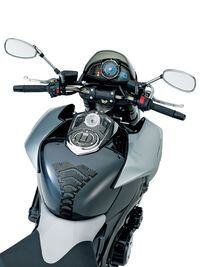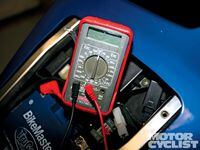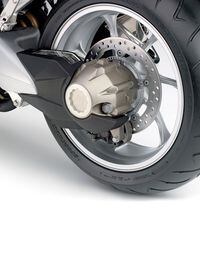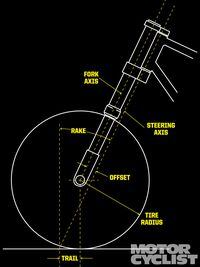Got A Question For Answers? Send It To mcmail@sorc.com
Gripping Stuff
Q I've just finished most of your Streetbike Surgery modifications on my '08 Suzuki B-King (MC, March 2009), and the results are fantastic. The only problem left is the stock hand grips. I was undecided at first, but after riding the bike harder, I hate the way they feel. What's the best way to perform a simple gripectomy? And since holding on is sort of crucial, what's the best way to make sure the new grips stay put? I used everything from hairspray to Permatex weatherstrip cement on my RM125 back in the day.
Jared Hunter
San Francisco, CA
**A **Who knows more about changing grips than a guy who designs and sells thousands of the things? Nobody. That's why we put your query to Paul Livingston at Spider Grips. His first piece of advice? Ask your favorite Suzuki wrench for tips specific to what you're riding and where. Beyond that, Spider Grip technicians start the operation with a clean incision through the old grips-shop scissors or a sharp box-cutter work fine as long as you don't slice into the handlebar or throttle tube. New grips won't stick to anything the old ones leave behind, so get rid of glue, grip material or residual mystery crud. "The cleaner the two surfaces, the more reliable the bond will be between them," Livingston says. "We use alcohol or contact cleaner to remove any remaining contaminates."
Now that everything is squeaky clean, break out the new grips. Like your shoes, there's a left and a right. Which is which? Look inside: The left grip is thicker, with a 7/8-inch inner diameter, while the thinner right grip has a 1-inch inner diameter to make room for the throttle tube. "Here at the Spider shop, we ride mostly in dry conditions, so our adhesive of choice is hairspray-essentially glue and alcohol-but a major brand of grip glue like Threebond 1501C Griplock works as well," Livingston says. Apply your sticky stuff evenly inside of the appropriate grip and quickly slide it on the bar or throttle tube. Now position both to your liking before the glue dries. "Let it set for 24 hours before you ride. Check the grips to be sure they're secure and that the throttle turns freely. Then check again. You can also add a couple turns of safety wire around the outside of the grips for additional hold. We do this for all of our competition bikes."
How Dead Is Dead?
Q In regards to testing a 12-volt motorcycle battery with a multimeter, I have been told that a functional battery should display a reading between 12.9 and 13.4 volts. What voltage would it show if the battery were dead-not good enough to charge and keep using? Could you explain it to me as if I were a third-grader? I'm not that electronically inclined.
John Hill
Tucson, AZ
A We'll keep it as simple as we can. Assuming we're talking about a normal lead-antimony battery here, you're looking for a voltmeter reading between 12.3 and 12.7 DC volts with no load, or at least 11.5 with the bike's lights turned on and the engine off. If you're using a multimeter, make sure it's set slightly higher than 13 volts in the DC range. That low-load test will give you a clearer picture of how healthy your battery is-or isn't. The good news is, barring fatal internal injuries like warped/cracked plates, a thick layer of white sulfation on said plates or a cracked case, a thorough charge should revive it.
To make sure you're getting an accurate reading, give the battery a quick once-over. Is there a layer of sediment on the bottom of the case? How's the electrolyte? A reading of 1.28 on your trusty hydrometer is good, but anything between. 1.23 and 1.26 means the battery needs a charge. If the electrolyte level is low, fill it to the prescribed level with distilled water. Not tap water; not acid: distilled water. Then charge it at 1/10th of the amp/hour rating-never more than 2.5 amps-to mix the water and electrolyte, or use a smart-charger to keep things at third-grade level. If the battery still won't hold a charge after all that, buy a new one.
Shafted
Q We have long known the difference between claimed horsepower at the crankshaft and real rear-wheel horsepower, and that chain final drive is more efficient than a shaft. I'm reasonably sure that a shaft-driven bike loses much more than 10 percent of its horsepower in the transfer. What's your educated estimate?
Chuck Koshiol
Painesville, MN
A It's true: Shaft drive is a less efficient way of transmitting power. Though the actual deficit depends on the design, manufacturing tolerances and other more esoteric factors, extra gear pairs and their inherent mechanical losses can eat up anywhere from 10 to 15 percent of an engine's output en route to the rear wheel. That shaft is heavier and more expensive relative to chain or belt final drive, but it's quieter and cleaner than a chain, and modern systems are essentially maintenance-free. As a wise man once said, you pays your money and you takes your choice.
Kreemed
Q In 1992, my Suzuki was painted and the tank was sealed with Kreem. The bike has become due for a repaint, but there's a debate about tank linings. One shop says to send the tank to an auto radiator shop and have them line it. Another says skip the lining because the ethanol in the gasoline would just eat it away. Is there another option?
Kevin Krebs
Houston, TX
A We've had better luck with Red Kote fuel-tank liner from Damon Industries (www.damonq.com), which seems to resist fuel additives from ethyl alcohol to tetraethyl lead as long as it's applied correctly. Still, ethanol is nasty stuff, so a radiator shop well versed in motorcycle fuel tank repair is probably your best bet.
Rake & Trail
Q "I don't understand rake and trail, or how they affect my motorcycle's handling. Can you explain the concept-in layman's terms?"
**A **Without turning this into a technical treatise, let's just say it's what's up front that counts. Rake is the angle between a line drawn through the motor-cycle's steering head and a vertical one, while trail is the distance between where that first line intersects the ground and another drawn vertically through the front axle.
MotoGP chassis engineers and other students of vehicle dynamics know there are more complex variables at play: the weight of the vehicle, the length of the wheelbase and the amount of steering offset, for starters. But reduced to simplest form, a chopper's relatively radical rake and longer trail make it harder to balance as well as harder to turn, particularly at slow speeds. Both variables are interrelated and inseparable, but trail is more influential when it comes to steering feel. Other variables being equal, bikes with less trail feel agile and responsive, while those with more trail require greater effort to deviate from a straight line. That's great for a relaxing troll down the interstate, but not so good for playing shopping-cart slalom in the Costco parking lot on Saturday morning.
















/cloudfront-us-east-1.images.arcpublishing.com/octane/VZZXJQ6U3FESFPZCBVXKFSUG4A.jpg)
/cloudfront-us-east-1.images.arcpublishing.com/octane/QCZEPHQAMRHZPLHTDJBIJVWL3M.jpg)
/cloudfront-us-east-1.images.arcpublishing.com/octane/HXOUJXQWA5HBHGRO3EMJIGFMVI.jpg)

/cloudfront-us-east-1.images.arcpublishing.com/octane/3TIWWRV4JBBOLDVGRYECVVTA7Y.jpg)
/cloudfront-us-east-1.images.arcpublishing.com/octane/KIX5O23D5NAIBGFXBN3327DKZU.jpg)
/cloudfront-us-east-1.images.arcpublishing.com/octane/7GJYDUIPXRGMTMQKN6ONYOLBOU.jpg)
/cloudfront-us-east-1.images.arcpublishing.com/octane/MUQLOVLL2ZDGFH25ILABNBXKTI.jpg)
/cloudfront-us-east-1.images.arcpublishing.com/octane/TNOU5DNE2BC57MFPMGN2EIDXAM.jpg)
/cloudfront-us-east-1.images.arcpublishing.com/octane/GTCXACQGJ5HAPDTGWUQKDEH44E.jpg)
/cloudfront-us-east-1.images.arcpublishing.com/octane/S35YGSEMEZB4BLTDJTSZPF4GLA.jpg)
/cloudfront-us-east-1.images.arcpublishing.com/octane/5UOT6HPX2JFMRJAX6EH45AR4MQ.jpg)
/cloudfront-us-east-1.images.arcpublishing.com/octane/OKWOJWAKP5EP3OACCRRWPCIX2Q.jpg)
/cloudfront-us-east-1.images.arcpublishing.com/octane/2WF3SCE3NFBQXLDNJM7KMXA45E.jpg)
/cloudfront-us-east-1.images.arcpublishing.com/octane/G4MG6OUCJNBSHIS2MVVOTPX65E.jpg)
/cloudfront-us-east-1.images.arcpublishing.com/octane/IIGGWFOTOJGB7DB6DGBXCCMTDY.jpg)
/cloudfront-us-east-1.images.arcpublishing.com/octane/QSTCM6AVEZA5JJBUXNIQ3DSOF4.jpg)
/cloudfront-us-east-1.images.arcpublishing.com/octane/U4I7G625B5DMLF2DVIJDFZVV6M.jpg)
/cloudfront-us-east-1.images.arcpublishing.com/octane/B6XD6LS6IVCQPIU6HXDJSM3FHY.jpg)
/cloudfront-us-east-1.images.arcpublishing.com/octane/ICL63FEDDRDTTMINYICCEYGMDA.jpg)
/cloudfront-us-east-1.images.arcpublishing.com/octane/FCGZHQXRBZFLBAPC5SDIQLVF4I.jpg)
/cloudfront-us-east-1.images.arcpublishing.com/octane/WNOB6LDOIFFHJKPSVIWDYUGOPM.jpg)

/cloudfront-us-east-1.images.arcpublishing.com/octane/X33NU3E525ECRHXLNUJN2FTRKI.jpg)